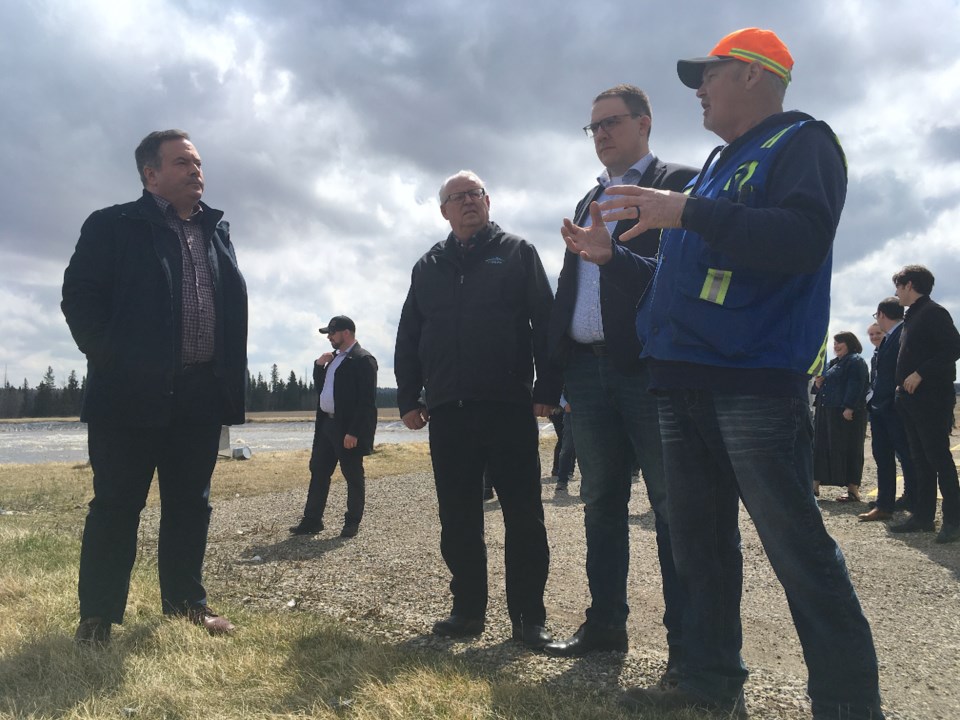SUNDRE — Provided the new wastewater treatment technology that will be trialled in town proves itself, Alberta’s premier said the provincial government would enthusiastically provide funding for municipalities with facilities in need of upgrades.
Jason Kenney visited on April 30 the future site of Sundre’s addition to the existing three-cell lagoon system, located immediately north of 12th Avenue NE on the east side of the James River Road.
The premier was accompanied by Rimbey-Rocky Mountain House-Sundre MLA Jason Nixon, who is also House Leader and Minister of Environment and Parks.
The two met with Sundre Mayor Richard Warnock and members of council who were joined by administrative staff and the municipality’s operations manager.
The technology, which employs a process known as electrofluccation that uses electric currents to separate waste materials from water in about an hour as opposed to months in traditional sewage lagoon cells, has been billed as a potential trend-setter that could span throughout the province.
The provincial government previously announced last summer $7.5 million in funding that the municipality could put toward the roughly $11-million project that will be piloted for one year.
The town’s administrative staff have told council in the past that the cost of expanding the existing lagoon with additional cells to increase capacity would have represented an estimated expense of more than $40 million.
Asked whether other municipalities, including First Nations communities, might anticipate similar funding from the provincial government to deploy the new technology, Kenney initially told the Albertan, “It’s really exciting to see this being piloted here.”
Having already been successfully trialled in a Saskatchewan town called Unity, the premier said the Rural Municipalities of Alberta believes the new tech “could be a game-changer” for wastewater treatment.
“The capital cost of a regular wastewater treatment plant, the mayor was just telling me, for this town would be $45 million,” he said. “We have a lot of rural municipalities, or smaller towns as well, that are struggling with population stagnation and the stagnation of their tax base, and then they get hit with an investment like that? It’s not doable. We could see a lot of municipalities go down as a result.”
Nixon added both Rural Municipalities of Alberta as well as Alberta Municipalities — formerly known as the Alberta Urban Municipalities Association — are excited about the project for two reasons.
“One is the lower cost for their members,” Nixon said. “And then second, is by doing all the regulatory hurdles here in one location, in partnership with the province, we’re able to then not have to see other small municipalities have to go through that regulatory process because it’s been tested, we know it’s safe, and then other municipalities can copy that technology.”
Nixon expressed confidence the project will succeed as it did in Unity, Sask.
“As long as we’re right, it should have a significant positive impact on small municipalities across the province,” he said.
For any other municipalities that decide to pursue this path once the pilot project completes the 12-month trial, the regulatory process will be reduced from some five years to less than a year “because all of the seasonal regulatory processes will have been handled in one location, as far as testing under different temperatures,” he said.
“I should also point out it’s got major implications for our Indigenous communities as well, who are dealing with very, very remote wastewater requirements. And this technology is very modular, very easy to move around, and very easy to construct in those remote locations,” he said.
Pressed for whether other municipalities, including First Nations communities, might in the future anticipate funding boosts such as Sundre received from the province to deploy the new tech, Nixon said, “Funding, when it comes to wastewater and water, is done in partnership with the province with most municipalities.”
There are throughout the constituency, he added, wastewater and water projects already underway that are receiving funding through Alberta’s department of transportation, “which is essentially our construction company inside the government.”
While Alberta Environment and Parks handles the regulatory aspect of such projects, Alberta Transportation comes in to help municipalities build them, Nixon said.
“There’s funding in every budget for wastewater projects,” Premier Kenney said, adding there is a wastewater portion included in the Alberta government’s Strategic Transportation Infrastructure Program.
“We do fund dozens of projects across the province, when a municipality puts that up as one of their top priorities."
However, conventional technologies that are currently more widely available have a tendency to be a lot more expensive, he said.
“So, we’d happily fund more wastewater projects at a lower cost like this — if the technology is proven,” he said.
Although Nixon did not immediately have exact numbers available, he said funding for such projects represent “a significant portion of the transportation department’s budget.”
Linda Nelson, Sundre's chief administrative officer, said engineering drawings for the new facility, which does not replace but rather complements the existing lagoon system, had just recently been received and that the permit process would be the next step prior to shovels going in the ground.
Responding to a follow-up question regarding whether the previously estimated cost of $45 million to proceed with an expansion of sewage cells included the long-term reclamation cost, Nelson said the expense was broken down into two phases.
The initial upgrades, which had to bring the facility in compliance with new environmental regulations by 2025, would have run up roughly $14.9 million, she said, adding a second upgrade would have represented another approximately $29.9 million.



